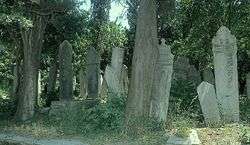Karacaahmet Cemetery
|
Old gravestones in Karacaahmet Cemetery | |
 Karacaahmet Cemetery | |
| Details | |
|---|---|
| Established | Mid-14th century |
| Location | Üsküdar, Istanbul |
| Country | Turkey |
| Coordinates | 41°00′40″N 29°01′34″E / 41.01111°N 29.02611°ECoordinates: 41°00′40″N 29°01′34″E / 41.01111°N 29.02611°E |
| Type | Public |
| Owned by | Istanbul Metropolitan Municipality |
| Size | 750 acres (3.0 km2) |
| No. of interments | over 1 million |
| Website | İBB Mezarlıklar Md. website |
The Karacaahmet Cemetery (Turkish: Karacaahmet Mezarlığı) is a 700-year-old historic cemetery, located in Üsküdar, the Asian side of Istanbul. Karacaahmet cemetery is the oldest in Istanbul and at 750 acres (3.0 km2), the largest burial ground in Turkey.
The cemetery was named after a warrior companion of Orhan I, the second Ottoman sultan and is believed to have been founded in the mid-14th century. It is estimated that over a million people are interred in the non-profit cemetery.[1]
Karacaahmet Cemetery comprises 12 parcels, each dedicated to different religious groups. Many historical headstones can still be seen with inscriptions written in the Ottoman Turkish alphabet, a version of the Arabic alphabet,. The burial ground is covered by high cypress trees.[2]
The shrine of Karaca Ahmet Sultan, a 13th-century physician and saint of Alevis, a sect of Islam, is situated within the cemetery.[3] There are also many other historical tombs and masjids, which is the Arabic word for mosques, built during the Ottoman period.
Notable burials
List in sorted order of the year of death.
- Historical
- Sheikh Hamdullah (1436-1520), calligrapher
- Benderli Ali Pasha, Sultan Mahmud II's Grand Vizier
- 1940s
- Kaçı Vehip Pasha (1877-1940), Ottoman general
- Ali bey Huseynzade[4] (1864-1940), Azerbaijani writer, thinker, philosopher, artist and doctor, and was the creator of the modern Flag of Azerbaijan.[5]
- 1950s
- Reşat Nuri Güntekin (1889-1956), novelist
- Cafer Tayyar Eğilmez (1877-1958),
- Osman Zeki Üngör (1880-1958), composer, initial conductor of the Presidential Symphony Orchestra, general
- 1960s
- Fikret Mualla Saygı (1903-1967), painter
- 1970s
- Nihal Atsız (1905-1975), nationalist writer, novelist, poet and philosopher
- 1980s
- Burhan Felek (1889-1982), journalist
- Oktay Rifat Horozcu (1914-1988), poet
- Ömer Boncuk (1917-1988), footballer and high school teacher
- 1990s
- Deniz Lokman (1974-1996), model
- 2000s
- Cem Karaca (1945-2004), rock musician
- Nezihe Viranyalı (1925-2004), female aviator
- Arif Mardin (1932-2006), Turkish-American music producer
- Mustafa Şekip Birgöl (1903-2008), retired colonel and the last veteran of the Turkish War of Independence
- Fazıl Hüsnü Dağlarca (1914-2008), poet
- Gazanfer Özcan(1931-2009), actor
- 2010s
- Esin Afşar (1936-2011), singer and stage actress
- Sait Maden (1931–2013), translator, poet, painter and graphic designer
- Oktay Sinanoğlu (1935-2015), theoretical chemist[6]
- Tahsin Şahinkaya (1925-2015), Air Force general and one of the five leaders of the 1980 military coup
- Kübra Meltem Mollaoğlu (1970-2015), civil activists parliamentary candidate
Damage by Marmaray project
By June 2007, a dent of 1.5 m diameter and 4 m depth occurred close to the cemetery wall, which was caused by the excavation works in the tunnel for Marmaray project. It was reported that some graves were damaged.[7]
See also
References
- ↑ "Time Out Istanbul". Time Out. Retrieved 2007-09-02.
- ↑ Municipality of Üsküdar (in Turkish)
- ↑ European Alevi Unions Confederation official website (in Turkish)
- ↑ Program kapsamında, anma toplantısı öncesinde Ali Bey Hüseyinzade’nin Üsküdardaki Karacaahmet Mezarlığındaki kabri ziyaret edildi.
- ↑ Whitney Smith. Flag Lore Of All Nations. — Millbrook Press, 2001. — P. 13. — ISBN 9780761317531
- ↑ Türk, Ümit (2015-04-26). "Oktay Sinanoğlu son yolculuğuna uğurlandı". Hürriyet (in Turkish). Retrieved 2015-04-26.
- ↑ Istanbul News (in Turkish)
